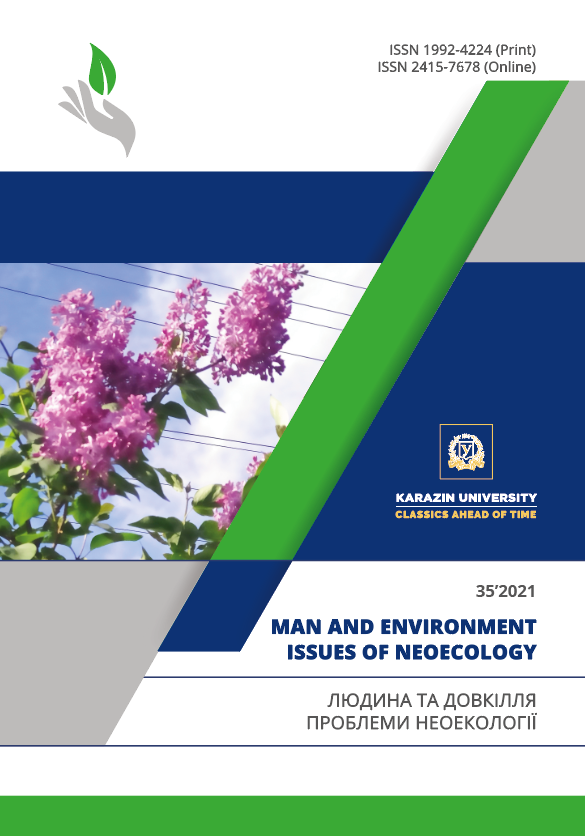Ecological Assessment of the State of Drinking Water Within the United Territorial Communities of the Enlarged Zhytomyr District
Abstract
Purpose. Assess the quality of drinking water of sources of decentralized water supply of rural settlements of Berezivka united territorial community of the enlarged Zhytomyr district.
Methods. Field, laboratory-analytical, statistical.
Results. As a result of research it is established that the greatest contribution to the pollution of drinking water is made by nitrates, the excess content of which was recorded on average in 50.7% of the selected samples, and in 57% of the studied settlements water belongs to quality class 4, "Limited" given undesirable quality. A critical situation was recorded in Bolyarka, Bondartsi, Dubovets and Cheremoshne villages, in which well water had increased content of nitrates in all selected samples. On average, 34% of the selected water samples do not meet the standard for the pH value in the direction of its reduction. In terms of pH, quality classes vary from "excellent", very clean to "good", clean water with a bias to the class of "satisfactory", slightly contaminated acceptable quality). The total iron content exceeded the standard by 6.6% of the selected samples.
Conclusion. It is proved that the formation of the general class of water quality is significantly influenced by a group of general sanitary indicators, which is primarily due to the high content of nitrates in the studied sources of decentralized water supply. The calculation of the integrated ecological index of development of rural settlements according to the indicators of drinking water quality showed that such rural settlements as: Zamozhne and Sadky need priority attention; 11 settlements need improvement; only village of Vasylivka needs support at the same level.
Downloads
References
Valerko, R. А., & Herasymchuk, L. O. (2020). Assessment of ecological integral index of rural settlements development in the radioactively contaminated territory based on drinking water quality indicators. Publishing House “Baltija Publishing”, 80–97. https://doi.org/10.30525/978-9934-588-45-7.5.
Kozak, V. I., & Kozliyk, O. O. (2019). Development of sectoral strategies and programs of water supply, sewerage and sanitation in the united territorial communities: methodical manual. Kyiv, DESPRO, 62 (In Ukrainian).
Chernyatina, V. A. (2015). The impact of decentralization on rural development. Theory and practice of public administration, I. 3, 162-166 (In Ukrainian).
Solving environmental problems in the regions: everything in the hands of communities? Retrieved from https://tyzhden.ua/Society/208470.
European waters. Assessment of status and pressure. European Environment Agency. (2018). Report № 7. Retrieved from https://www.eea.europa.eu/publications/state-of-water.
Burow, K. R., Nolan, B. T., Rupert, M. G. & Dubrovsky, N. M. (2010). Nitrate in Groundwater of the United States. Environmental Science and Technol, 44 (13), 4988-4997. https://pubs.acs.org/doi/10.1021/es100546y
Kelly, V. R., Cunningham, M. A., Curri, N., Findlay S. E., & Carroll S. M. (2018). The Distribution of Road Salt in Private Drinking Water Wells in a Southeastern New York Suburban Township. Journal of Environment Quality. 2018. Vol. 47. № 3. Р. 445-451. DOI: https://doi.org/10.2134/jeq2017.03.0124
Jones, A. Q., Dewey, C. E., Doré, K. …& Henson S. J. (2006). Public perceptions of drinking water: a postal survey of residents with private water supplies. BMC Public Health, 94. https://doi.org/10.1186/1471-2458-6-94
Charrois, J.W.A. (2010). Private drinking water supplies: challenges for public health. CMAJ, 182(10), 1061-1064. https://doi.org/10.1503/cmaj.090956
Bayanova, A. A. (2019). Monitoring the quality of drinking water of the regional decentralized water supply. IOP Conf. Ser.: Earth Environ. Sci. 315 052014. https://doi.org/10.1088/1755-1315/315/5/052014 (in Russian).
Palapa, N. V. (2009). Pollution of drinking water in rural areas and measures to improve its quality. Agroecological journal, 3, 43-45 (In Ukrainian).
Palapa, N. V. (2015). Assessment of rural residential areas by drinking water quality. Agroecological journal, 4, 41-47 (In Ukrainian).
Valerko, R. A., Herasymchuk, L. O. (2020). Organic agriculture as a factor influencing the content of nitrates in drinking water sources of decentralized water supply of rural settlements. Environmental sciences, 3(30), 124-128. https://doi.org/10.32846/2306-9716/2020.eco.3-30.21 (In Ukrainian).
On the formation and liquidation of districts: Resolution of the Verkhovna Rada of Ukraine № 807-IX of 17.07.2020. Retrieved from https://zakon.rada.gov.ua/laws/show/807-IX#Text (In Ukrainian).
Berezivka village council. Retrieved from http://berezivsca.gromada.org.ua.
About the statement of the State sanitary norms and rules "Hygienic requirements to drinking water intended for human consumption". Retrieved from https://zakon.rada.gov.ua/laws/show/z0452-10 (In Ukrainian).
DSTU 4808:2007. Sources of centralized drinking water supply. Hygienic and environmental require-ments for water quality and selection rules. Kyiv, 2007 (In Ukrainian).
Pustovit, I. M. (2013). Methods for determining the ecological and social assessment of the territories of rural settlements of Ukraine. Scientific reports of the NULES, 1(37). Retrieved from http://www.nbuv.gov.ua/e-journals/Nd/2013_1/13pim.pdf
Authors reserve the right of attribution for the submitted manuscript, while transferring to the Journal the right to publish the article under the Creative Commons Attribution License 4.0 International (CC BY 4.0). This license allows free distribution of the published work under the condition of proper attribution of the original authors and the initial publication source (i.e. the Journal)
Authors have the right to enter into separate agreements for additional non-exclusive distribution of the work in the form it was published in the Journal (such as publishing the article on the institutional website or as a part of a monograph), provided the original publication in this Journal is properly referenced
The Journal allows and encourages online publication of the manuscripts (such as on personal web pages), even when such a manuscript is still under editorial consideration, since it allows for a productive scientific discussion and better citation dynamics (see The Effect of Open Access).





